#pancho diaz
Photo

Bad movie I have Very Bad Things 1998
#Very Bad Things#Initial Entertainment Group#Jon Favreau#Leland Orser#Cameron Diaz#Christian Slater#Rob Brownstein#Jeremy Piven#Daniel Stern#Jeanne Tripplehorn#Joey Zimmerman#Tyler Cole Malinger#Kobe Tai#Russell B. McKenzie#Pancho Demmings#Blake Gibbons#Angelo Di Mascio Jr.#Lawrence Pressman#Steve Fitchpatrick#Brian Grandison#John Cappon#Linda Klein#Byrne Piven#Bob Bancroft#Trey Davis#Marilyn McIntyre#Wrangler#Trooper#Peter Berg#Brian Sampson
6 notes
·
View notes
Text
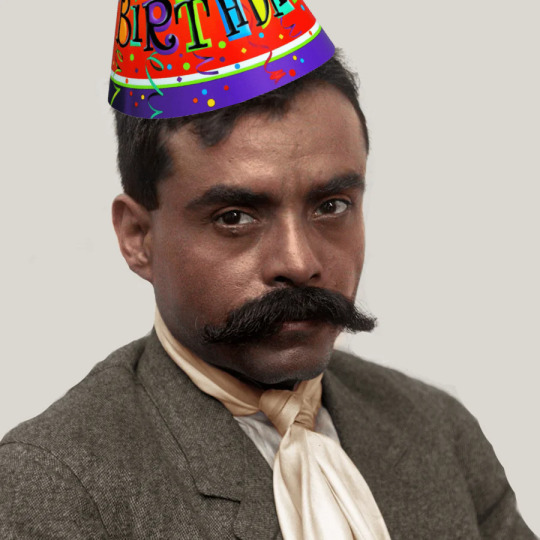
Happy birthday, Emiliano Zapata! (August 8, 1879)
A celebrated rebel and freedom fighter of the Mexican Revolution, Emiliano Zapata was born in a rural community in the state of Morelos. Though his family was fairly well-off, Zapata came to identify strongly with Mexico's peasant class and was a figure in the movement against the landlords and Mexican President Porfirio Diaz from early on before taking up arms. Zapata's army, mainly peasants, became known as the Zapatistas, and helped to depose Diaz, only to come into further conflict with the moderate revolutionary government of Francisco I. Madero. Zapata attempted to institute land reform under the Plan of Ayala in the territory his forces controlled in Morelos, which led Madero to attack the Zapatistas. Zapata was able to rout the federal forces out of Morelos, and supported the northern forces led by Pancho Villa, Venustiano Carranza, and Álvaro Obregón in overthrowing the federal government. Zapata later broke with Carranza and once again went to war with federal forces. This time, however, Zapata was killed in an ambush. Afterward, Zapatistas under Obregon drove Carranza from power. Zapata remains influential and beloved among the rural population of Mexico, inspiring the Zapatista rebellion in Chiapas.
“If there is no justice for the people, let there be no peace for the government.”
594 notes
·
View notes
Text
El Origen del Cine en México y su influencia en el Revolución
En nos mundo hoy día, el arte del cine es una forma importante de entretenimiento. Las familias pueden sentarse y mirar un gran número de películas que los hacen reír, llorar, o gritar. Con el cine, los creadores pueden demostrar sus ideas y visiones tanto genuinas como ficticias. En nos opinión, el cine tiene un capacidad a hacer un persona sentía una nueva emoción, y se cambia ideas. En vista de este, un país donde el cine tenido un gran influencia en la publica es México. En México, el cine ha convertido en una de las más grandes formas de arte, y es un instrumento para contar historia y ha sido usado para cambiar como la sociedad trabaja. ¿Pero cuándo empezó esto?
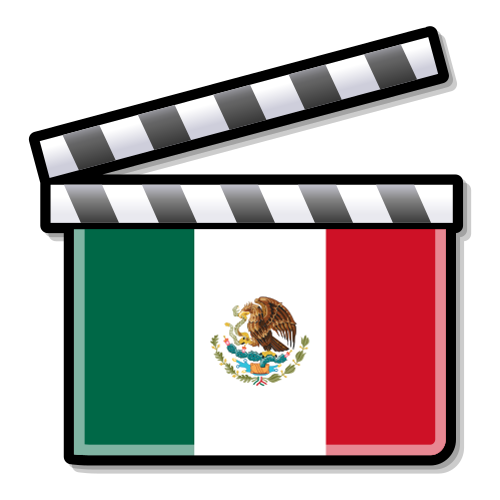
De acuerdo con los muchos fuentes nosotros estudiamos, el origen del cine en México empezó en 1896 cuando el invención del cinemagraph creó una nueva forma de capturar momentos y mostrarlos a la gente. El presidente de México al tiempo, Porfirio Diaz, usa cine para capturar eventos en políticos que él crea fue importante en la historia de México. Con esas películas, eventos como la primera reunión con los presidentes de México y los Estados Unidos fue documentó para la gente de México a ver. Documentales fue las solos películas hago durante esto era, y no hay dudo que estos documentos ayudan personas a aprendieron acerca de eventos más. Al mismo tiempo, muchas personas empezaron a usar el cine para decir novelas que la audiencia pueda mirar. Estas personas fueron nombradas cineastas. Cineastas empecé rápidamente a hacer nueva formas a mostrar cine, usando musica más importante de la cultura de Mexico a acompañaba sus películas. Esta aquí que nosotros vemos cine empezó a tener un influencia en la gente de Mexico.

Porfirio Diaz
El aumento en el uso de cine ocurrió al mismo tiempo con el empiezo del un revolution contra presidente Porfirio Diaz. Por treinta años, Diaz tuvo una dictadura en México, y la gente empezó a luchar contra el dictador. Usando la forma de arte Diaz ha usado, cineastas empezaron a usar cine a capturar eventos en el revolution y pintaron una imagen contra el presidente y en favor del revolution. Cineastas no mostraron solo batallas verdades contra el presidente, porque ellos además crearon películas que capturan los líderes del revolución como leyendas. Francisco Madero fue un líder de revolución contra Diaz, y cineastas como Jesús H. Abitia, Salvador Toscano, y los hermanos Alva usando las cámaras a creando documentales que ayudaron a la gente de México a saber acerca de la revolución y cambio como ellos piensan. Estos películas documento los lideres de la revolution en un luz positivo y tenido un gran efecto en como la gente sentía acerca de la revolution. Por consiguiente, sin el invención del cine, el revolution pueda no hace.
Nate
Las corporaciones cinematográficas tenían el poder para transformar los héroes de la revolución a figuras legendarias. Creo que los legados de hombres como Francisco Madero, Emiliano Zapata, y Pancho Villa son inmortalizados gracias a los cineastas que documentaron sus acciones. Pero, la influencia del cine en la revolución Méxicano es más profundo de este hecho. Según varios historiadores, las corporaciones tenían la habilidad para decidir planes de batalla por los líderes que documentaron. Hay rumores que un corporación estadounidense diría a Pancho Villa cuando no había luz abundante para grabar con video un batalla, y como resultado Villa cambiaría los tiempos de sus batallas. Evidentemente, las corporaciones cinematográficas tenían mucha influencia sobre la revolución y las personas claves.
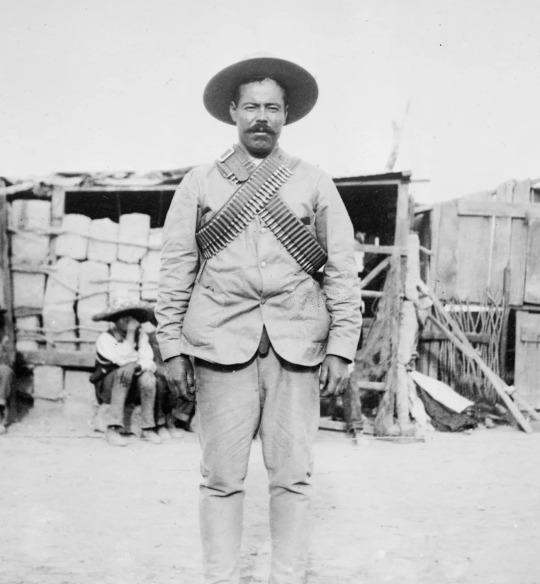
Pancho Villa
Pero, mientras cinema afectaba la revolución Méxicano, en mi opinión el efecto de la revolución en la industria cinemática de México era más grande. En las decadas desde la revolución, cineastas mexicanos han hecho cientos de películas sobre los eventos que pasó. Empezando en 1933, el cineasta Fernando de Fuentes creó un trilogía de películas: El prisionero trece, El compadre Mendoza, y Vámonos con Pancho Villa. Estos películas muestran la extensión de la violencia y traición que estaba común durante la revolución. En mi opinión, estas películas representan la revolución es algo muy malo, y servir como un mensaje contra la violencia en general.
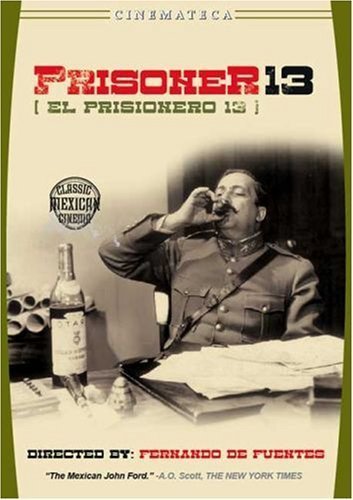
Un póster de la película El Prisionero 13
La película Flor silvestre, creaba por Emilio Fernández en 1943, contaba la historia de un amor prohibido y el efecto de la revolución en la relación de un padre y su hijo. El protagonista, José Luis, se casa con una mujer pobre y se convierte a un miembro de la revolución. Por eso su padre lo echó de la casa, pero los hermanos de José Luis que no apoyan la revolución matan a su padre. Esto causa un conflicto entre José Luis y sus padres, y en al final la familia está destruida. Creo que el punto principal de Flor silvestre es para demostrar la destrucción emocional que estaba causado por la revolución, fuera de las batallas.
La revolución mexicano estaba muy influida por los cineastas porque estas personas eran responsables por los legados de los revolucionarios importantes. Pero al mismo tiempo, la revolución proveía la industria cinematográfica con muchas cuentas que necesitaban ser contados, y es responsable por algunas de las películas más populares de la historia de cine mexicano.
Wyatt
“Myth, Mexico, and the Movies | Research.” 2022. Bu.edu. 2022. https://www.bu.edu/research/our-research/research-magazine/2009-toc/snapshots/myth-mexico-and-the-movies/.
Wood, David. n.d. “Film and the Mexican Revolution.” Accessed October 7, 2022. http://www.revistascisan.unam.mx/Voices/pdfs/8806.pdf.
Museum, Dallas. 2017. “Times & Places - Mexico: Mexican Cinema (1900-1950) - DMA Collection Online.” Dma.org. 2017. https://collections.dma.org/essay/GQ1A51wn.
“Film Card - Torino Film Fest.” 2019. Torino Film Fest. 2019. https://www.torinofilmfest.org/en/15-festival-internazionale-cinema-giovani/film/flor-silvestre/4290/.
5 notes
·
View notes
Video
vimeo
Hardmade | Best Summer from PEDRO PINTO on Vimeo.
CREDITS:
Agency: Cukier
Creative Director: Filip Kniej
Production: OTO Film
Executive Producer: Tomek Kozera
Producer: Marcin Borek
Service Production Company : Tantor Films Chile
Director: Pedro Pinto
Cinematographer: Leandro Ferrão
1st AD:Diego Medina
2nd AD: Diego Escobar
Movi: Pancho Herrera
Movi Assit: Agustin Herrera
Key Grip: Jorge Diaz
QTake: Ricardo Calderón
DIT: Cristian Robles
Drone: Ariel Marinkovic
Production Designer:Daniela Clementi
Set Dresser: Beatriz Contreras
Stylist: Dominique Duhalde
Hair & Make up: Francisca Bongardt
Stills Photographer: Wojciech Barczuk
Product Specialist: David Huerta
Editor: Alessandro Dordoni / Konrad Styczen
Grading: Daniel Palluca
VFX: Pedro Pinto & Christian Mu
Music / Sound Design: Blut Audio
0 notes
Video
vimeo
ESCUDO NEGRA DC from JIMMY FERNANDEZ on Vimeo.
Director: Jimmy Fernandez
Director de Foto: MIguel Bunster
Productora Ejecutiva: Maca Keller
Director de Arte: Caco Huerta
Jefa de Producción: Paula Fernandez
Locaciones: Felipe Herrera & Eder Hepp
Asst. de producción: Pancho Baldivia
Asst. de campo: Tomas Carboni
Productor Técnico: Pablo Rojas
Maquillaje: Carolina Fernandez
Vestuario: Alejandra Salinas
Vestuario Asst. Katerine Jara
1er AC: Pelao Flores
2nd AC: Rogelio Ramirez
Ambientación: Eduardo Ureta
Producto: Victor Jorquera
Video asst. Daniel Lara
DIT: Mateus Olguin
Jefe Electrico: Fabian Olguin
Electrico: Ivan Olguin
Electrica: Carolina Diaz
Op. Astera: Williams Aragon
Op. Movi: Piero Leiva
Post & Sonido VD: Jimmy Fernandez & DVD Medios
Montaje VD: Jimmy Fernandez
1 note
·
View note
Photo
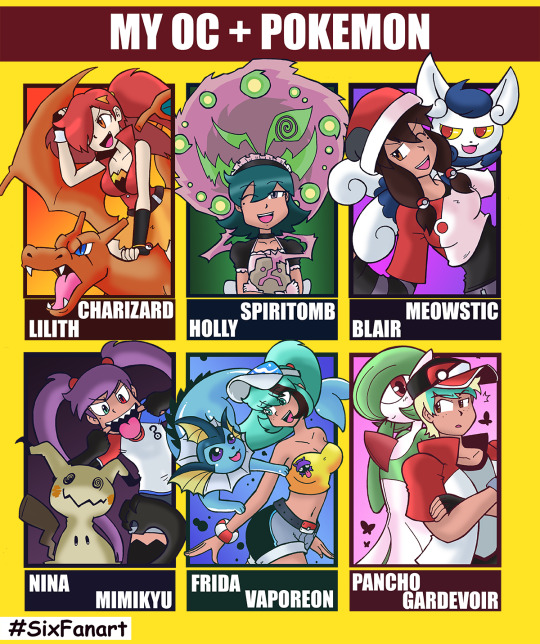
MY OC + POKEMON
Estos son mis OC selecctionados y con su Respectivo Poke Acompañante
#6 drawings#las hermanas diaz#pancho diaz#gardevoir#Frida Diaz#vaporeon#nina diaz#mimikyu#blair diaz#meowstic#holly diaz#spiritomb#lilith diaz#charizard#pokemon#star vs the forces of evil
57 notes
·
View notes
Text
Hell Hath No Fury like Women Armed to the Teeth



The Mexican Revolution had no shortage of strong women, many of whom had no qualms about leading a large group of rebels against (what they viewed as) an unjust government.
These women who were just as fierce (two of which have previously been discussed on this page) as the medieval and Renaissance women from popular history. However, unlike the affluent women of the aforementioned eras, revolutionary women had a LOT to lose. But they never backed down. Most of them received were far from the radicals that their rivals depicted them as. From their POV, they were fighting for a cause greater than them. Initially some joined the fight to aid their husbands and other male relatives but as time went on, they became fully committed to the movement.
Another similarity between these women and the iconic women of the medieval and Renaissance eras is the contrast between each ideological movement. The two main revolutionary leaders/”bandidos” (aka bandits) of the Mexican Revolution are Emilian Zapata and Doroteo Arango (better known as Pancho Villa). While the two men had a lot in common, their movements differed. Zapata’s movement had more to do with land rights. The women in his movement, like their leader himself, echoed his sentiment when he said, “es mejor morir de pie que vivir de rodillas.” (“It is better to die standing than live on your knees.) As such, those on the opposite end, knew that these were women who wouldn’t fight till the bitter end.
In the North, where most of Pancho Villa's forces were, revolutionary women were equally feared. Some of them took up leadership positions. Many of these women had become part of this movement since before Franciso I. Madero's election. They were against the Porfiriato (Porfirio Diaz' dictatorship which lasted for three decades). Their celebration of Madero's election as Mexico's new president was cut short following his assassination. With the country plunged into civil war, they took up arms. What ensued is one of the bloodiest conflicts in Mexican history. The women who fought in this conflict, used every weapon at their disposal. Some cotributed by using the pen rather than the sword to fight, while others did both, arming themselves to the teeth. Then there were the women on the opposite end, who were wholly against the revolutionary movement and sided with the government. They too made themselves heard.
Images: Emiliano and Eufemio Zapata with their respective wives. Clara de la Rocha with her father and fellow revolutionary fighter, Herculano de la Rocha. Armed mother and soldadera with her sons at each side.
26 notes
·
View notes
Text




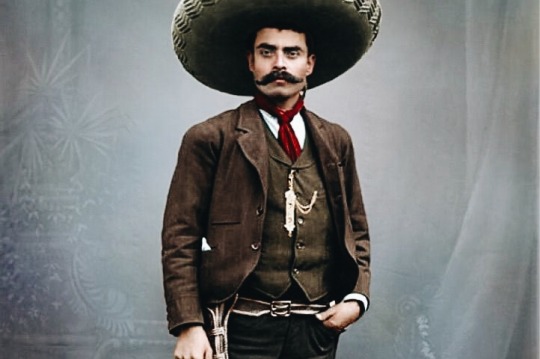
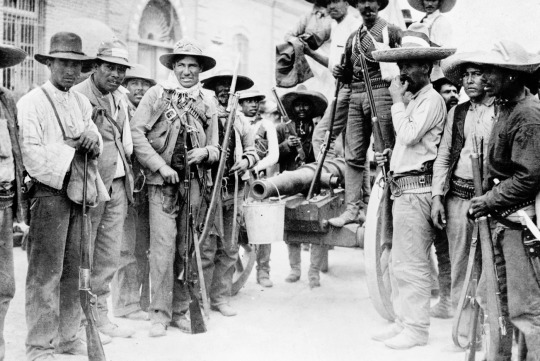
Emiliano Zapata Salazar (8 August 1879 – 10 April 1919) was a leading figure in the Mexican Revolution, during which he formed and commanded the Liberation Army of the South, an important revolutionary brigade.
Emiliano Zapata was born in Anenecuilco, Morelos, to a landless, but not poor, family which dealt in livestock. Orphaned at 16, he sharecropped and traded horses in his birth-place. During the closing years of the Porfirio Diaz dictatorship Zapata took part in local opposition politics, with a 6-month interruption while he served as a soldier.
In September 1909 Zapata was elected president of the group in Anenecuilco designated to reclaim the community's ejidal lands. He backed the unsuccessful opposition gubernatorial candidacy of Patricio Leyva. In March 1911, after several months of contact with the maderistas, Zapata joined the rebellion against Diaz. The major effort of the zapatistas was an attack on Cuautla.
With the fall of the Diaz regime Zapata initiated his recurring demands—land for the peasants, removal of federal troops from Morelos, and designation of an acceptable commander of state forces. The efforts of the interim De la Barra regime, endorsed by Francisco Madero, to discharge the revolutionary forces irritated Zapata, who became incensed when during the Madero's pacification efforts Francisco de la Barra ordered Victoriano Huerta to march into Morelos in August 1911.
Zapata's view of revolutionary goals was quite parochial, and he was unwilling to await patiently the results of Madero's dreamed-of democratic processes to effect land reform. Nineteen days after Madero assumed the presidency, Zapata revolted under the Plan of Ayala. Waging guerrilla warfare, as he had before and would again, Zapata began distribution of ejidal lands in Puebla in April 1912 and followed with other distributions in Morelos and Tlaxcala. Agricultural students were employed in the formation of agrarian commissions. Program and strategy for the moustached and almost illiterate Zapata were formulated by a group of intellectuals, including Antonio Diaz Soto y Gama and schoolteacher Otilio Montaño.
After Madero's death, Zapata joined with Pancho Villa and Venustiano Carranza in an uneasy alliance to defeat Huerta. However, it was the carrancistas who occupied Mexico City, and the First Chief (Carranza) sought to control the situation through the Convention of Generals. Villista and zapatista opposition forced removal of the gathering to Aguascalientes, where the representatives of Zapata had the first public and national hearing of their cause.
The Plan of Ayala was accepted in principle, and the convention government was established, resting on the armed support of Villa and Zapata. Their joint armies occupied the Mexican capital in December 1914. However, cooperation in subsequent military operations was another matter. As Álvaro Obregón led his Constitutionalist army back toward Mexico City, Villa withdrew to the north and Zapata turned back southward into Morelos.
From 1915 on Zapata waged defensive guerrilla warfare against the Constitutionalist. Forces under Gen. Pablo González sought, as others before, to wipe out the zapatistas without success. Finally, González sent Col. Jesús Guajardo to trick Zapata into receiving him as an ally. Zapata was ambushed and killed at Chinameca on April 10, 1919.
53 notes
·
View notes
Photo


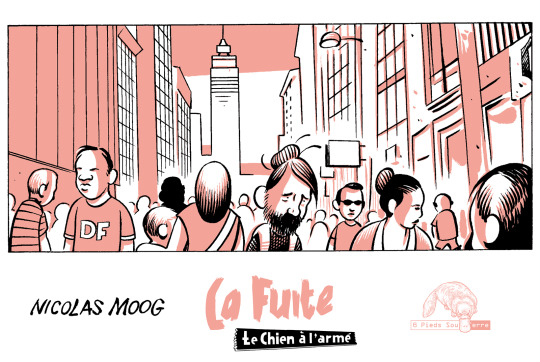

LA FUITE, le chien à l'armé
par Nicolas Moog
C'est demain, jeudi 17 février, que le nouveau livre de Nicolas Moog Buenaventura Diaz arrive en librairie.La fuite est une sombre aventure intérieure qui se mue en périple géographique, d'Hambourg à Mexico, puis en quête symbolique, à la recherche de la tête de Pancho Villa. Magique !
“Juan voulait faire de notre découverte imminente un scoop. Je ne lui en laissais pas le temps. Du temps, il m’en avait fallu déjà beaucoup pour commencer à comprendre. Comprendre que ce n’était pas en restant enchaîné à la table à dessin qu’un quelconque déclic allait se produire.” - Nicolas Moog
#librairies#comics#pancho villa#autofiction#graphic novel#roman graphique#bd#bande dessinée#livres#books
5 notes
·
View notes
Text
#StarWars
O cabelo da Princesa Leia foi inspirado nas mulheres da Revolução Mexicana. Uma das marcas mais icônicas da personagem imortalizada por Carrie Fisher na saga Star Wars era seu penteado. Em 2002, George Lucas disse à revista Time que o coque de Leia foi inspirado nas revolucionárias mexicanas do início do século XX que, sob o comando de Pancho Villa e Emiliano Zapata, lutaram contra a ditadura do general Porfírio Diaz em busca de uma reforma agrária.
Fonte: Dias de Cinefilia

4 notes
·
View notes
Photo

#revolucion mexicana#infographic#infografia#20th century#siglo xx#madero#huertas#porfirio diaz#emiliano zapata#pancho villa
9 notes
·
View notes
Text
RATO, ELENA

Elena Rato, licenciada en Bellas Artes por la Universidad de Salamanca, formada en la especialidad de pintura y en la Universidad Politécnica de Valencia en escenografía, con incursiones en el ámbito del diseño y la performance, actualmente compagina la producción artística con la docencia.
Esta creadora, con residencia y estudio-taller en Asturias, es una de las figuras más sólidas y completas del arte emergente asturiano en los ámbitos de la pintura y la instalación; con un buen historial de exposiciones nacionales e internacionales; un creciente palmarés de galardones y una progresiva incorporación de su obra a notables colecciones y entidades públicas y privadas como las Fundaciones Ortiz-Gurdian de Nicaragua,; Alimerka y Diaz Caneja de España, el Museo Nacional de Danza en Cuba, el Gobierno de Cantabria, o la Consejería de Cultura del Principado de Asturias, entre otros.
Ha sido premiada en el XLII Certamen Nacional de Arte de Luarca, el Certamen Nacional de Pintura Contemporánea “Casimiro Baragaña” o el de Arte Joven Pancho Cosío del Gobierno de Cantabria. En 2017 recibe la Beca nacional Residencias PLUS de la Universidad de Alicante. Más recientemente resultó finalista en Obra Abierta de Caja Extremadura y Accésit en el XXIV Premio de Pintura ‘Ciutat d’Algemesí’, 2019.
Entanglement fue su primera exposición individual en Estados Unidos, de la mano de la galería The Americas Collection, Miami. También en el 2014 destaca “Soft shot” en el Museo Barjola de Asturias, proyecto enmarcado en el Festival Nacional Miradas de Mujeres.
Ha participado en muestras colectivas tales como NTENSA, organizado por la Consejería de Cultura del Gobierno del Principado de Asturias, 2018; Asturias, arte actual. La forma del concepto; Celebrating Art Basel with Tiffany, Miami; Nuevos itinerarios Casa Obra Pía, La Habana, Cuba, Openart Centro de Historia de Zaragoza; Expresión contemporánea asturiana, México D.F.



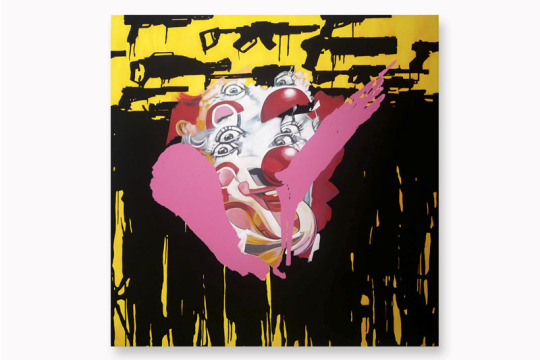

http://elenarato.com/
#RATO ELENA#RATO#R#WOMAN#UNIVERSIDAD DE SALAMANCA#ESPAÑA#UNIVERSIDAD POLITÉCNICA DE VALENCIA#ESCENOGRAFÍA#DISEÑO#PERFORMANCE#DOCENTE#ASTURIAS#TALLER#PINTURA#INSTALACIÓN#CERTAMEN NACIONAL DE ARTE DE LUARCA#CERTAMEN NACIONAL DE PINTURA CONTEMPORÁNEAS#CASIMIRO BARAGAÑA
1 note
·
View note
Text
MEXICAN REVOLUTION
The Mexican Revolution was an armed conflict that began in Mexico on November 20, 1910. The antecedents of the conflict go back to the situation in Mexico under the dictatorship known as the Porfiriato. Porfirio Díaz exercised power in the country in a dictatorial manner from 1876 to 1911. During these 35 years Mexico experienced remarkable economic growth and had political stability, but these achievements were made with high economic and social costs, which were paid by the less favored strata of society and political opposition to the Diaz regime. During the first decade of the 20th century, several crises broke out in various spheres of national life, reflecting the growing discontent of some sectors with the Porfiriato.
After President Porfirio Díaz was elected for a new presidential term (1910-1914), the former candidate and liberal leader Francisco I. Madero launched the Plan of San Luis - dated October 5, 1910 - to overthrow him.
His main motto was "Effective suffrage, no re-election", and he demanded labor rights and the distribution of land that social groups opposed to Díaz were seeking.
His action plan included a call for armed struggle: "On November 20, starting at 6 in the afternoon, but the Aquiles brothers, Máximo and Carmen Serdán, upon being discovered in possession of weapons, rose before the date agreed in Puebla.
The death of the brothers when confronting government forces led them to be considered the first "martyrs" of the movement against Díaz, in addition to motivating others to the insurrection.
In fact, there was no coordinated uprising on November 20, 1910 at 6 in the afternoon to overthrow Díaz, because by that time there were already "13 acts of arms in different states."
The armed struggle gave rise to other revolutionary leaders who accompanied the cause of Francisco I. Madero, among others Emiliano Zapata in the south of the country, as well as Francisco "Pancho" Villa (his real name was Doroteo Arango), Álvaro Obregón and Pascual Orozco in the north.
The revolutionary pressure was successful and Porfirio Díaz signed his resignation from the presidency on May 25, 1911, ending 35 years of government and opening the way for new elections.
Francisco I. Madero won the vote and assumed the presidency of Mexico on November 6, 1911 in what is considered "the first democratic election in 30 years"
Although the movement succeeded in removing Díaz, the new government did not respond promptly to popular revolutionary demands.
Soon the struggles began between those who were allies at the beginning of the armed uprising, as each side assumed itself as the true defender of revolutionary ideals.
Zapata launched the Ayala Plan under the banner of the agrarian struggle, while Orozco published the Empacadora Plan on social demands. Both were unaware of the Madero presidency.
The Maderista government managed to defend itself for two years against the Zapatista, Orozquista insurgents, and other smaller groups, with the support of Villa's troops.
Women, on all sides, played a role as a support force for the revolutionaries and even had armed participation. They were known as "Las Adelitas".
The Embassy Pact - known as such because it was signed at the United States headquarters in Mexico - was successful, although it did not originally have Huerta as the one chosen for the presidency.
To combat Huerta, called "the usurper", a reorganization of revolutionary forces from the north led to the creation of the Constitutionalist Army, under the command of Venustiano Carranza.
With the Plan of Guadalupe, he focused the revolutionary struggle against Huerta until the coup president left power in July 1914 and Carranza assumed the government.
The Aguascalientes Convention between revolutionary leaders led to the lack of recognition of Carranza as president, which is why again two large sides are opened: the conventionists and the constitutionalists.
Carranza, who calls himself "the maximum leader of the revolution," moves his government to Veracruz, while the conventionists name Eulalio Gómez as president.
From then on came a guerrilla war.
The armed struggles between the sides, in which the bulk of the deaths occur - calculated at more than a million -, lasted from October 1914 to November 1916.
In that month, the government and army of the Conventionists declared their end, although diminished Zapatista and Villista forces continued their struggles for months.
The balance finally tips towards the forces of Carranza, who from September 1916 convened a Constituent Congress to draft a new Magna Carta of the country.
The constituents, elected by popular vote at the end of that year, worked on a plan to reunify the revolutionary causes until the beginning of 1917.
After being voted on January 31, the new Constitution is promulgated on February 5, 1917, marking what is considered the end of the Mexican Revolution.
2 notes
·
View notes
Photo

FELIZ CUMPLEAÑOS A PANCHO
ayer fue dia del Surfing y en la mitad del mundo comenzo el Verano
me hubiera gustado subirlo antes
pero tuve que llevar mi PC a hacerle mantenimiento
41 notes
·
View notes
Text

“L'ignoranza e l'oscurantismo non hanno mai prodotto altro che masse di schiavi al servizio della tirannia.”
Quando Emiliano Zapata aveva solo nove anni assistette alla violenza che i proprietari terrieri messicani scatenavano contro le famiglie dei contadini. Chiese a suo padre, un povero campesino, perché nessuno si opponeva. Lui disse che non si poteva fare nulla.
Il bambino ripose: “quando crescerò gli restituirò tutto.”
E fu fedele alle sue parole.
In quel Messico, a cavallo tra 800’ e 900’, più del 90% dei terreni erano nella mani di pochi latifondisti mentre i braccianti e i piccoli contadini facevano la fame. E se disgraziatamente provavano a lamentarsi arrivavano i rurales, i gendarmi a cavallo, che reprimevano nel sangue ogni minima rivendicazione. Furono proprio i rurales ad arrestare Emiliano, sedicenne ed orfano di entrambi i genitori, per la prima volta nel 1897. Evaso, fu costretto ad abbandonare casa e famiglia.
Dopo alcuni anni di esilio tornò nella sua città natale, Anenecuilco, dove venne eletto calpuleque (sindaco). Nel 1910 si oppose al candidato governatore sostenuto dagli agrari ed iniziò a promuovere l’occupazione delle terre alla testa dei contadini della regione. Il governo, una dittatura militare guidata dal generale Porfirio Diaz, lo bollò come bandito.
E così Emiliano decise di prendere le armi. Era l’inizio della Rivoluzione Messicana.
Pancho Villa al Nord e Zapata al Sud, strinsero d’assedio il traballante “trono” di Diaz, contribuendo con la loro guerriglia senza tregua alla sua definitiva deposizione.
Il nuovo governo, presieduto da Francisco Madero, inizialmente appoggiato dai rivoluzionari, tradì le speranze legate alla promulgazione della tanto agognata riforma agraria. E così Zapata, dopo aver rifiutato la tenuta e il vitalizio che gli vennero offerti, tornò a combattere.
“La terra appartiene a chi la lavora con le mani” era il concetto alla base del Piano di Ayala, un progetto di espropriazione delle terre padronali a favore dei poveri campesini da lui promosso. Intanto, mentre la lotta nel sud del Messico diventava sempre più violenta e le fila degli zapatisti si ingrossavano fino a comprendere quasi 30.000 uomini, il generale Huerta depose ed uccise Madero.
Ma la sua, sarà una breve dittatura. Nel 1914 dopo tre anni di guerra civile Zapata e Villa, nuovamente alleati, entrarono a città del Messico. Qui Emiliano rifiutò la poltrona presidenziale, preferendo tornare tra la sua gente per organizzare la “comune di Morelos”, uno esperimento unico di democrazia diretta e redistribuzione delle terre.
Nel 1919, mentre la guerra civile era ripresa senza sosta, Zapata venne attirato in un imboscata ed ucciso da sicari governativi. Il suo omicidio, lungi dal decretarne l’oblio, ne aumentò a dismisura la fama. Molti di quei contadini che aveva guidato nella lotta si rifiutarono di crederlo morto e in tanti giurarono di averlo visto cavalcare ancora nel buio della notte messicana.
Cannibali e Re
48 notes
·
View notes
Video
youtube
Le Mexique vit depuis 1876 sous le régime de Porfirio Diaz et connait des inégalités de plus en plus criantes. A l'approche de l'élection présidentielle de 1910, l'opposition s'organise. La révolution qui éclate va connaitre plusieurs phases destructrices, plongeant le pays dans une guerre civile. De grandes figures révolutionnaires vont émerger, comme Pancho Villa ou Emiliano Zapata. Revenons sur les grandes étapes de la révolution mexicaine, et observons comment elle a tenté de répondre aux volontés de changement.
3 notes
·
View notes